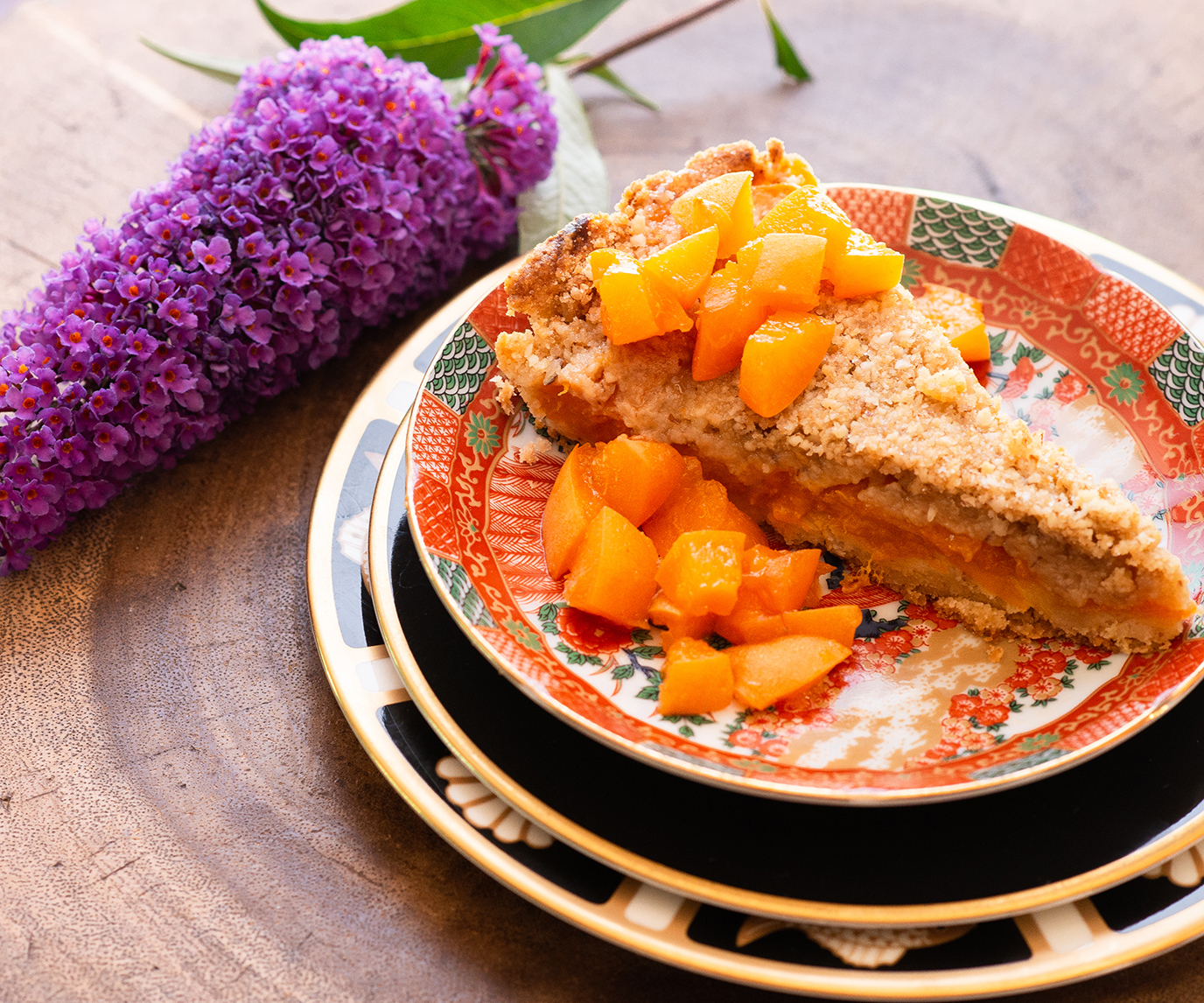JOIN ME FOR THE WAVE!
IT’S STONE FRUIT SEASON, PEOPLE!
In my mind, it doesn’t get better than stone fruit season–ripe as it is with the promise of baking and aromas and pleasurable eating, but, alas, not everyone is feeling the love this year. There is a wonderful apricot tart recipe as the end of this post, but, first I want to tell you a cautionary tale about a small breakdown in grocery store etiquette. The story begins in the fruit aisle.
I was gathering fuzzy orange-gold apricots into my biodegradable produce bags at my local Jon’s Supermarket the other day when, out of nowhere, I was approached by a lady wearing a wide flower-patterned headband that partially covered her medusa-like reddish hair.
“What are you going to make with all those apricots?” she asked as I was filling my second bag and as she was picking up a bag of her own. (There were a gazillion apricots filling the store’s bins, by the way. There was no shortage.)
Startled, I mumbled that I was going to bake an apricot tart because Jon’s apricots looked beautiful. “It’s always hard to find good apricots,” was my distracted but not unfriendly reply and I kept bagging.
For some reason, my answer seemed to irritate my new friend at the apricot bin. Before I could even begin to tune into the drama unfolding around me, she had pivoted to face the apple aisle and yelled to “Bob,” a casually-dressed man who apparently was her husband, “She’s going to make an apricot tart!” The edge to her voice made her point clear. She might as well have added, “Can you believe that?”
Soon it seemed that people in the vicinity of the apricot bin were staring at us curiously. Bob, however, just proffered a half-disinterested “what?” and kept studying the sale produce. Not to be ignored—especially, apparently, by Bob—the apricot lady yelled to Bob again, this time even more loudly. “She’s making a tart,” trailing out the word tart as if it were a foul four-letter word.
I just stood there. What in the world? Had I wandered into some kind of Sterlingesque cultural minefield by admitting that I was making a tart? Was I being pranked? Candid Camera, maybe?
Or, wait! Was it me? I checked the strap of my purse to see if I was still wearing my Bernie button. Nope. I was clean. No triggers there.
Or, wait–again! Maybe it was just her. Maybe road rage has found its nasty way into the produce aisles, reducing one of our last areas of semi-civility to dust. Or, maybe she just needed a hug…or an apricot.
Whatever. I tied the little twisty tops onto my bags of apricots and ducked into the anonymity of the check-out line. (What? You thought I was going to leave the apricots behind just because I was being harrangued by a stranger? Blue Cayenne had a post deadline! I can be one tough cookie when I need to.)
As I drove home, I made it a point to refocus upon my plan to bake the beautiful apricot tart recipe I had bookmarked in David Lebovitz’s book, Ready for Dessert, and to write a bit about the glories of beautiful apricots. I’d gotten my groove back.
Here is that part of my post.
After I had enjoyed every moment of baking the tart–It is superb, by the way– I started doing a little more research on apricots. Did you know that, fragile as they are, apricots have been around for thousands of years, probably first being cultivated in China and Central Asia? Or that thereafter, they were carried across the Eurasian steppe by what one writer colorfully described as bands of “nomadic, horseback-riding tribesman?” I didn’t know that but reading the history of apricots set me to musing; can’t you just picture rough-and-tumble warriors, pockets packed with apricots, bare-chested except for tight little leather vests… Nevermind.
Apricots are called a lot of names around the world—golden apples, Armenian plums, The Precocious One, yellow plums and on and on. They’ve also insinuated themselves into colloquial expressions. There is an absolutely wonderful Turkish expression that goes like this: “It doesn’t get better than an apricot in Damascus.” (Translation: You can’t show me anything better than that!)
The Persians have an apricot saying, too. When someone makes an improbable boast, the sarcastic response is sometimes, ” when the apricots bloom…” or, “Tomorrow there will be apricots.” The apricot expression is the Persian equivalent of “when pigs fly.”
Lest you dismiss my promise of a great apricot tart recipe with references to apricots blooming tomorrow, here it is– and it’s a delicious gem of a recipe, too. Worth the wait.
Me? I’m going back to buy more apricots tomorrow. I’ve found an Ottolenghi recipe for Poached Apricots with Pistachios and Amaretto Cream that I just can’t wait to try. Tell you the truth, though, I’m really hoping not to run into that downer of an apricot lady again. If I do, maybe I’ll try telling her the one about the nomadic, horseback-riding tribesmen.
Ingredients
- 1 C. flour
- 1/2 C. sliced unblanched almonds
- 1/4 C. granulated sugar
- 1/8 t. salt
- 1/2 C. cold unsalted butter (cut into 1/2-inch pieces)
- 1 large egg yolk
- 1/2 C. flour
- 1/3 C. packed light brown sugar
- 3 ounces almond paste (crumbled)
- 1/4 C. sliced unblanched almonds
- 4 T. cold unsalted butter (cut into 1/2 inch pieces)
- 12-14 fresh ripe apricots (about 1 1/4 pounds)
- 1 T. cornstarch
- 1/4 C. granulated sugar (more to sprinkle on top of the finished tart if the apricots are less-than-sweet)
- Chopped fresh apricots for garnish
Instructions
- Prepare a tart pan by greasing it lightly.
- Preheat your oven to 400 degrees F.
- Make the dough in your food processor fitted with the metal blade. Process 1 cup of flour, 1/2 C. sliced almonds, 1/4 C. granulated sugar and the salt until the nuts are finely ground. Pulse the chilled butter pieces into the flour mixture and continue to process until the mixture looks like coarse meal. Now, add the egg yolk and process until the dough just begins to come together and form clumps.
- Remove the dough from your processor and press it into the bottom of your tart pan with your fingers. Try to get the dough evenly distributed in the tart pan and be sure to push some of the dough up the sides of the pan so that your tart will have a pretty edge. Cover the tart pan with plastic wrap and let the dough chill in your refrigerator for at least an hour. The dough will feel fairly firm when you remove it from the refrigerator. Once removed from the refrigerator, use the tines of your fork to poke holes into the bottom of the tart shell. Make about a dozen holes. Bake the tart shell in your 400 degree F. oven for about 20 minutes. If the shell begins to puff up while baking, press the dough down with the back of a heat-proof spatula. When the tart shell is baked, remove it from the oven and let it cool while making the filling.
- Decrease oven temperature to 375 degrees F.
- Use the same food processor with the same metal blade for making the filling. There is no need to clean the bowl. Process together 1/2 C. flour, brown sugar, almond paste and 1/4 C. sliced almonds until you can see that the almond paste is broken into fine pieces in the flour mixture. Add 4 T. chilled butter and process the mixture until the butter pieces have begun to break down. The butter pieces should now be about the size of peas. Set aside but move quickly to put the tart together.
- Prepare your fresh apricots by halving and pitting them and slicing them into 1/2-inch slices. Toss the sliced apricots into a bowl with the cornstarch and 1/4 C. sugar (or a bit more if your apricots aren't particularly sweet).
- Spread the apricot slices (now softening in the sugar/cornstarch mixture) evenly in the bottom of the tart pan. You wil want to include as much of the cornstarch and sugar mixture that is now clinging to your apricots in your pie. The cornstarch will thicken the apricot juices so that your pie won't be runny. The sugar will diminish any excessive tartness in the apricots.
- Sprinkle the almond/flour mixture over the apricots that you have now arranged in the tart shell. Using your hands, be sure the crumbly almond/flour mixture is distributed evenly on top of the apricots.
- Bake until the fruit is bubbling and the topping is beginning to brown. This will take about 30 minutes. Watch your tart carefully at the end of baking. You don't want your crust to burn. Remove your tart from the oven and let it cool to allow the fruit juices to thicken and to make it easier to cut neat slices to serve your guests..
- This tart is best served warm or at room temperature and would be spectacular with a scoop of good quality vanilla ice cream.
You can buy Lebovitz’ book at Amazon. Here is the link: Amazon.


 Save Recipe
Save Recipe
2 thoughts on “Apricots!”